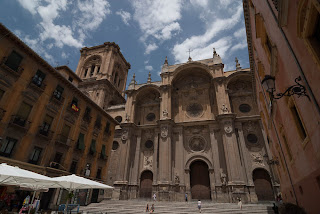
 Most of the buildings in Alhambra are Islamic, but some Christian buildings exist. Many of the buildings were cordoned off, but books in the bookstore show photos of rooms which have much of the original plaster and tile and colour in place - it must have been incredible!
Most of the buildings in Alhambra are Islamic, but some Christian buildings exist. Many of the buildings were cordoned off, but books in the bookstore show photos of rooms which have much of the original plaster and tile and colour in place - it must have been incredible!

The room of secrets was inside double nested walls and when standing in the very center you could not hear what was being spoken in the corners. But the person in the opposite corner could hear you very clearly! They really loved their scientific discoveries.
 We sauntered through the aromatic fountains and gardens and trees of Alhambra over to Generalife - the "closer to God" escape for the original Muslim residents.
We sauntered through the aromatic fountains and gardens and trees of Alhambra over to Generalife - the "closer to God" escape for the original Muslim residents. Here the gardens and fountains were the focus and extremely elaborate. Roses and Orange trees were imported. The walkways are full of fountains, labyrinths, yew archways and many other flora extravagances.


By 7:30pm were were climbing the final tower of Alhambra and although still very much daylight, the lighting was getting better for photo taking as we closed the visiting hours.
views here from the top of Alhambra down over Granada
Almost every building has one (or more) tiles with either a unique design or inscription. I'd love to do one on our own house if we do end up building!
Back at the bottom main square looking up at Alhambra (that's the tower I was on doing the Titanic scene above). We ate a couple of meals in the main plaza here.

Woke up later the next day (hopefully catching up from the jet lag). Caught a bus to the Granada Cathedral - wow.

The cathedral was built at the height of Spanish domination of South America - and they were showing it off. Endless cupolas and chapels all around the edges - each with more ornate displays than the last it seemed.


 Marucia was intrigued by the dual organs (below) and I agree that it would be ideal to hear them being played as you were walking around. They would bring the space alive.
Marucia was intrigued by the dual organs (below) and I agree that it would be ideal to hear them being played as you were walking around. They would bring the space alive.
Not photo'd here, but G.L. found some Gregorian chant books in the back section which were very interesting as they pre-dated modern musical notation. Their notation represented the musical scale, but not the duration of the notes (tempo). The notes were squares and diamonds vs. circles and rings. They were spread out across the page, so I thought perhaps that was a way of representing the tempo, but G.L. pointed out that this was merely due to filling the space between the accompanying text.


We were kicked out at 1:30 for closing, so went to off to find our cerveza and tapas.






We were kicked out at 1:30 for closing, so went to off to find our cerveza and tapas.























No comments:
Post a Comment